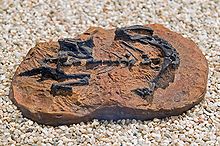Mussaurus
| Mussaurus Temporal range: Early Jurassic,
| |
|---|---|

| |
| Fossil juvenile skeleton | |
| Scientific classification | |
| Domain: | Eukaryota |
| Kingdom: | Animalia |
| Phylum: | Chordata |
| Clade: | Dinosauria |
| Clade: | Saurischia |
| Clade: | †Sauropodomorpha |
| Family: | †Mussauridae Bonaparte & Vince, 1979 |
| Genus: | †Mussaurus Bonaparte & Vince, 1979 |
| Type species | |
| †Mussaurus patagonicus Bonaparte & Vince, 1979
| |
Mussaurus (meaning "
In its early stages of life, Mussaurus was a small quadrupedal herbivore, walking on all four legs. As it grew up, the changes in body proportions may have led its centre of mass to move backwards towards its pelvis. Adults would have been medium-sized bipedal herbivores, measuring up to 8 metres (26 ft) long and weighing up to 1.2–1.6 metric tons (1.3–1.8 short tons).
Numerous specimens of varying age found in a single locality suggest that Mussaurus is one of the earliest dinosaurs to have lived in a gregarious lifestyle. With its possible origin from the Triassic, this complex social behaviour may have given rise to the sauropods' early success as the largest herbivores on land. Mussaurus also possessed anatomical features that suggest a close, possibly transitional evolutionary relationship with true sauropods.
Discovery

Infant and juvenile fossils of Mussaurus were first discovered by an expedition led by
Classification
Previous to the discovery of adult specimens of Mussaurus, the
| Plateosauria |
| |||||||||||||||||||||||||||||||||||||||||||||||||||||||||||||||
Palaeobiology

Mussaurus specimens have been found in association with nests that are believed to contain multiple eggs apiece. The skeletons of Mussaurus infants were small, measuring about 20 centimetres (7.9 in) long and weighing about 53.3–76.5 grams (1.88–2.70 oz).
Social behaviour
As of 2021, Mussaurus represents the earliest unequivocal evidence of complex social behaviour in dinosaurs, with over 100 eggs and skeletal specimens of 80 individuals ranging from embryos to adults found in the same locality. This discovery predates the previous records of herd-living dinosaurs by at least 40 million years. It is thought that this behaviour has been originated from the Triassic period, leading them to become successful as large terrestrial herbivores.[2]
Growth

A study published in May 2019 shows that in its first year of life, during which it weighed 6.5–10.2 kilograms (14–22 lb), M. patagonicus probably a was
References
- ^ ISBN 0-7853-0443-6.)
{{cite book}}: CS1 maint: multiple names: authors list (link - ^ PMID 34675327.
- ^ S2CID 86110822.
- ^ Holtz, T. R.; Rey, L. V. (2007). Dinosaurs: The Most Complete, Up-to-Date Encyclopedia for Dinosaur Lovers of All Ages. Random House. Supplementary Information 2012 Weight Information
- ^
- OCLC 985402380.
- S2CID 251181122.)
{{cite journal}}: CS1 maint: multiple names: authors list (link
Further reading
- Bonaparte, J. F.; Vince, M. (1979). "El hallazgo del primer nido de dinosaurios triasicos, (Saurischia, Prosauropoda), Triasico Superior de Patagonia, Argentina [The discovery of the first nest of Triassic dinosaurs (Saurischia, Prosauropoda,) from the Upper Triassic of Patagonia, Argentina]". Ameghiniana. 16 (1–2): 173–182.
- Pol, D.; Powell, J. E. (2007). "Skull anatomy of Mussaurus patagonicus (Dinosauria: Sauropodomorpha) from the Late Triassic of Patagonia". Historical Biology. 19 (1): 125–144. S2CID 85170509.
